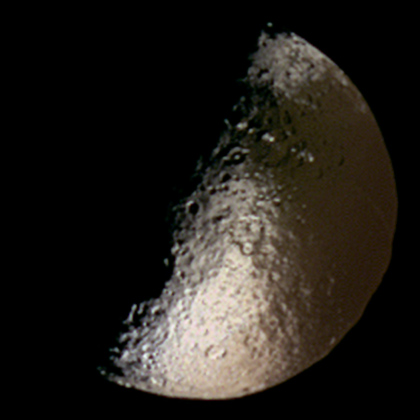Emily Lakdawalla • Sep 20, 2007
Iapetus' "Voyager Mountains"
When Voyager 2 flew by Iapetus in 1981, it found a line of white dots marching along the equator from Iapetus' bright trailing side into its dark leading side. Images shot with the white dots on Iapetus' limb seemed to suggest that the dots were, in fact, a line of peaks, protruding above the mysterious dark material. These peaks came to be referred to as the "Voyager mountains."

NASA / JPL / PDS Rings Node / Seti Institute / Emily Lakdawalla
The Voyager 2 flyby of Iapetus
Voyager 2 took a sequence of images of Iapetus as it flew past the Saturn system in August of 1981. In these images, a line of white dots could be seen at the edge of Iapetus' dark region. As Voyager 2 flew up and over Iapetus' north pole, it became evident that the white dots formed a line of mountains on Iapetus' equator.
NASA / JPL / Space Science Institute
Iapetus in false color
This view was produced from three captured through ultraviolet, green, and infrared filters on October 15, 2004. An intriguing line of white peaks sticks up above the brownish dark terrain. The full resolution image has been enlarged by a factor of two to show detail.
NASA / JPL / SSI / mosaic by Emily Lakdawalla
Iapetus' Voyager mountains
During its September 10, 2007 flyby of Iapetus, Cassini skimmed above Iapetus' equatorial ridge, passing over the "Voyager mountains." High-resolution images taken during the closest approach reveal that the white spots aren't peaks sticking out above the dark material, but are instead the bright flanks of individual mountain peaks.Inset images at upper right show the context of the observation.
If you'd like to play around with the Cassini Iapetus data, I've put a page together that will make it easier for you to find images and match them up:Links to images and metadata for Cassini's Iapetus flyby
Because of the safing event that happened to Cassini when it started returning the data to Earth, the playback got a bit discombobulated. Most of the data wound up being returned, but on the JPL raw images site it's all out of order, with very few of the wide-angle context images being sorted together with the narrow-angle high-resolution shots that were taken at the same time. With a bit of sleuthing and a lot of help from Tilmann Denk's website I figured out which images go where, and also which images were missing. There are a few broken links on the page; these refer to images that Cassini took, but, for whatever reason, were not returned to Earth, or at least have not made it to the raw images website yet.
Support our core enterprises
Your support powers our mission to explore worlds, find life, and defend Earth. You make all the difference when you make a gift. Give today!
Donate

 Explore Worlds
Explore Worlds Find Life
Find Life Defend Earth
Defend Earth

